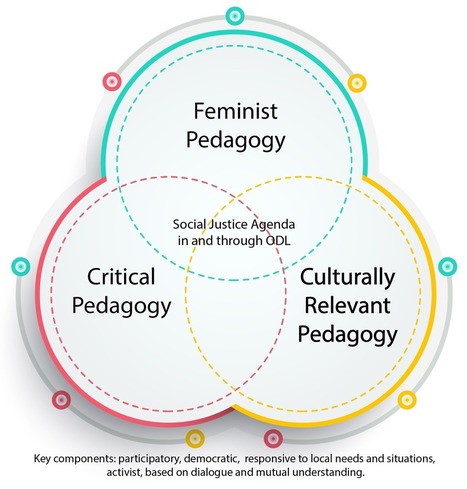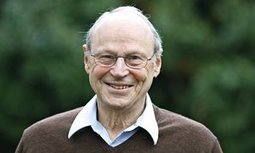 Your new post is loading...
 Your new post is loading...
Gender inequality is a pressing issue on a global scale, yet studies on this important issue have stayed on the margins of open and distance learning (ODL) literature. In this study, we critically analyse a batch of ODL literature that is focused on gender inequality in post-secondary and higher education contexts. We use Therborn’s social justice framework to inform and guide the study. This is a comprehensive social justice lens that sees inequality as “a life and death issue,” approaching empowerment as a central area of concern. Qualitative content analysis of 30 years of peer-reviewed literature reveals patriarchy and androcentrism as significant mechanisms that continue to produce gender inequality, in particular in women’s access to educational resources and formal learning opportunities. We highlight three themes that emerged in the content analysis: (1) ODL and equal opportunity; (2) Feminism and gender-sensitive curriculum design; and (3) Culturally relevant curriculum design. We critique views of access to technology-enabled education as an instrument for social justice, and provide a pedagogical model for an ODL curriculum centred on empowerment and agency, two concepts closely linked to existential inequality. We argue that such a curriculum is public service and requires a model of education that is based on participation and co-construction, and lies at the intersection of critical, feminist, and culturally relevant pedagogical practices.
Via Elizabeth E Charles
When I say that the MOOC is not a thing, then, what do I mean? If it is not a course one enters and exits, if it is not the content bound up within its learning management system, if it is not a product of which we can dispute the value, intentions, and results — activities that have been the centrifuge of the MOOC debate — what is it?
The MOOC is a strategy. In “March of the MOOCs: Monstrous Open Online Courses,” Jesse writes, “A MOOC isn’t a thing at all, just a methodological approach, with no inherent value except insofar as it’s used.” As with all methodological approaches, the MOOC is neutral. Much the way any tool is inherently neutral — a screwdriver in a toolbox, a chalkboard in the classroom, a phone in the pocket — the MOOC isn’t this or that, positive or negative, good or bad, well-intentioned or malicious, until it is put into play. Many people will argue with this position, and I’m quick to admit that it’s politically fraught, but it is this neutral space, this imaginative space, this generative space that we must hold in order to understand what it is that we missed about MOOCs, and which we must not miss again. Also, for this exegesis to work, we must refuse to see “MOOC” as a mere acronym and must instead interrogate it alongside words like “approach,” “lens,” “pedagogy,” “praxis.”
“Massive” and “Open” suggest the typical limitations of the classroom have been lifted, including the strictures of social norms and power structures of the traditional (dysfunctional) teacher-student relationship. Most efforts to realize the MOOC in any practical sense (Coursera, Udacity, and others) first begin by divesting themselves of true openness, instead inventing a partial openness, or a strategically reframed idea of “open” that can yet include enough of the banking model of education to keep instructors, institutions, and also students anchored, fixed. The reduction of “open” to mean “access” or “free,” for example, is the result of a fundamental misunderstanding of what openness in education entails. “Free” suggests a product or transaction; “access” requires gatekeepers and permissions; whereas “open” suggests community. The openness the MOOC presages is one where agency trumps position, where a student can become a teacher, a teacher a student, and the whole endeavor of education becomes a collaboration. It is not openness like a door is open, it is open the way a mind is open.
Via Miloš Bajčetić
|
Teachers should embrace a radical pedagogy and provoke students to demand equality for themselves and others, argues vice principal Tait Coles Schools must develop a commitment to civic courage and social responsibility that ignites bravery in young people to realise they have the power and opportunity to challenge the status quo. School leaders have a duty to promote learning that encourage students to question rather than forcing teachers to lead drill-oriented, stimulus-and-response methodologies. Teachers must awaken the passions of their students and teach the knowledge and skills needed to direct and sustain it. Students need the freedom and encouragement to determine and discover who they are and to understand that the system shouldn't define them – but rather give them the skills, knowledge and beliefs to understand that they can set the agenda. Educators must be prepared to embrace a radical pedagogy and believe that each school should be one of freedom that provokes students to fight against the corridors of power and enforce equality for themselves and others. Critical pedagogy is the only way to achieve this. The philosophy was first described by Paulo Freire and has since been developed by the likes of Henry Giroux, Peter McLaren and Roger Simon. Critical pedagogy isn't a prescriptive set of practices – it's a continuous moral project that enables young people to develop a social awareness of freedom. This pedagogy connects classroom learning with the experiences, histories and resources that every student brings to their school. It allows students to understand that with knowledge comes power; the power that can enable young people to do something differently in their moment in time and take positive and constructive action. Learn more / En savoir plus / Mehr erfahren: http://www.scoop.it/t/21st-century-learning-and-teaching/?tag=Radical+Pedagogy
Via Nik Peachey, Gust MEES
ed“Pedagogy is not ideologically neutral.” This line has been for me almost a mantra over the last several years. I’ve said variations of it on Twitter, on the About Us page of Hybrid Pedagogy, on the site for the Hybrid Pedagogy Inc. non-profit, and in our recent CFP focused on Critical Digital Pedagogy. I’ve circled around this phrase, because I feel increasingly certain that the word “pedagogy” has been misread — that the project of education has been misdirected — that educators and students alike have found themselves more and more flummoxed by a system that values assessment over engagement, learning management over discovery, content over community, outcomes over epiphanies. Education (and, to an even greater extent, edtech) has misrepresented itself as objective, quantifiable, apolitical.
Higher education teaching is particularly uncritical and under-theorized. Most college educators (at both traditional and non-traditional institutions) do little direct pedagogical work to prepare themselves as teachers. A commitment to teaching often goes unrewarded, and pedagogical writing (in most fields) is not counted as “research.”
The entire enterprise of education is too often engaged in teaching that is not pedagogical. There are a whole host of other words I’d use to describe this work: instruction, classroom management, training, outcomes-driven, standards-based, content delivery. Pedagogy, on the other hand, starts with learning as its center, not students or teachers, and the work of pedagogues is necessarily political, subjective, and humane.
What is Critical Pedagogy?
Critical Pedagogy is an approach to teaching and learning predicated on fostering agency and empowering learners (implicitly and explicitly critiquing oppressive power structures). The word “critical” in Critical Pedagogy functions in several registers:
Critical, as in mission-critical, essential;
Critical, as in literary criticism and critique, providing definitions and interpretation;
Critical, as in reflective and nuanced thinking about a subject;
Critical, as in criticizing institutional, corporate, or societal impediments to learning;
Critical Pedagogy, as a disciplinary approach, which inflects (and is inflected by) each of these other meanings.
Via Miloš Bajčetić
|



 Your new post is loading...
Your new post is loading...













